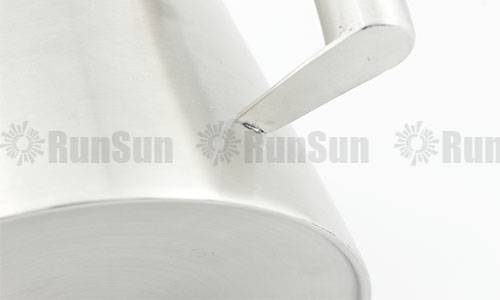
What are the materials of the stainless steel watering can?
- According to the main chemical composition, it can be divided into chromium stainless steel, chromium-nickel stainless steel, chromium manganese nitrogen stainless steel, chromium-nickel molybdenum stainless steel, ultra-low carbon stainless steel, high molybdenum stainless steel, high purity stainless steel, etc.;
- Classified according to the performance characteristics and use of steel, such as nitric acid resistant (nitric acid grade) stainless steel, sulfuric acid-resistant stainless steel, pitting resistant stainless steel, stress-resistant stainless steel, high strength stainless steel, etc.
- Classified according to the functional characteristics of steel, such as low-temperature stainless steel, non-magnetic stainless steel, free-cutting stainless steel, superplastic stainless steel, etc.
- American stainless steel classification: features and uses of 200, 300, 400 series products.
Commonly used stainless steel materials are: 201, 202, 301, 303, 304, 304L, 316, 316L, 321, 310S, 401, 409, 410, 420J1, 420J2, 430, 439.
In layman’s terms, stainless steel is steel that is not easy to rust. In fact, some stainless steels have both rust resistance and acid resistance (corrosion resistance). Good anti-corrosion properties are 304 and 316, which can be used in the food industry.
Classification of austenitic stainless steel:
Physical classification
In layman’s terms, stainless steel is steel that is not easy to rust. In fact, part of stainless steel has both rust resistance and acid resistance (corrosion resistance).
The rust resistance and corrosion resistance of stainless steel are due to the formation of a chromium-rich oxide film (passivation film) on its surface. This rust resistance and corrosion resistance are relative.
Tests have shown that the corrosion resistance of steel in weak media such as the atmosphere and water and oxidizing media such as nitric acid increases with the increase of the chromium content in the steel. When the chromium content reaches a certain percentage, the corrosion resistance of the steel changes suddenly. , That is, from easy to rust to not easy to rust, from no corrosion resistance to corrosion resistance.
There are many ways to classify stainless steel. According to the organization structure at room temperature, there are martensitic, austenitic, ferritic, and duplex stainless steels;
According to the main chemical composition, it can be basically divided into two systems: chromium stainless steel and chromium-nickel stainless steel;
According to the purpose, there are nitric acid-resistant stainless steel, sulfuric acid-resistant stainless steel, seawater resistant stainless steel, etc. According to the corrosion resistance type, it can be divided into pitting corrosion-resistant stainless steel, stress corrosion-resistant stainless steel, intergranular corrosion-resistant stainless steel, etc.;
According to the functional characteristics, it can be divided into non-magnetic stainless steel, free-cutting stainless steel, low-temperature stainless steel, high-strength stainless steel, and so on.
Because stainless steel has excellent corrosion resistance, formability, compatibility, and toughness in a wide temperature range, it has been widely used in heavy industry, light industry, daily necessities industry, and architectural decoration industries.
Chemical classification
Ferritic stainless steel is stainless steel whose main structure is ferritic in use. The chromium content is between 11% and 30%, and it has a body-centered cubic crystal structure.
This kind of steel generally does not contain nickel, and sometimes contains a small amount of Mo, Ti, Nb, and other elements. This kind of steel has the characteristics of large thermal conductivity, small expansion coefficient, good oxidation resistance, and excellent stress corrosion resistance. It is mostly used to make atmospheric resistance. , Water vapor, water, and oxidizing acid corroded parts.
This type of steel has disadvantages such as poor plasticity, significantly reduced plasticity, and corrosion resistance after welding, which limits its application. The application of out-of-furnace refining technology (AOD or VOD) can greatly reduce interstitial elements such as carbon and nitrogen, which makes this type of steel widely used.
Austenitic-ferritic duplex stainless steel is stainless steel in which austenite and ferrite each account for about half of the structure. In the case of low C content, the Cr content is 18% to 28%, and the Ni content is 3% to 10%. Some steels also contain Mo, Cu, Si, Nb, Ti, N, and other alloying elements.
This type of steel has the characteristics of austenitic and ferritic stainless steel. Compared with ferrite, it has higher plasticity and toughness, no room temperature brittleness, and significantly improved intergranular corrosion resistance and welding performance, while still maintaining iron The 475℃ brittleness, high thermal conductivity, and superplasticity of element stainless steel.
Compared with austenitic stainless steel, it has high strength and significantly improved resistance to intergranular corrosion and chloride stress corrosion. Duplex stainless steel has excellent pitting corrosion resistance and is also nickel-saving stainless steel.
Martensitic stainless steel can adjust its mechanical properties through heat treatment. Generally speaking, it is a kind of hardenable stainless steel.
Typical grades are Cr13 type, such as 2Cr13, 3Cr13, 4Cr13, etc. The hardness is higher after the pure fire, and different tempering temperatures have different combinations of strength and toughness.
Mainly used for steam turbine blades, tableware, and surgical instruments. According to the difference in chemical composition, martensitic stainless steel can be divided into martensitic chromium steel and martensitic chromium-nickel steel.
According to the different structures and strengthening mechanisms, it can be divided into martensitic stainless steel, martensitic and semi-austenite (or semi-martensitic) precipitation hardening stainless steel, and maraging stainless steel.

